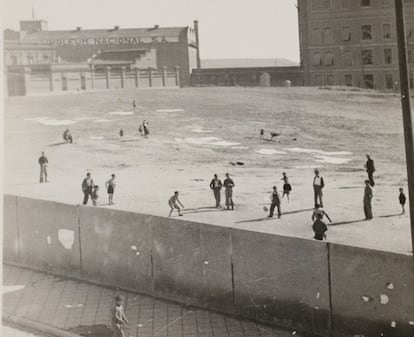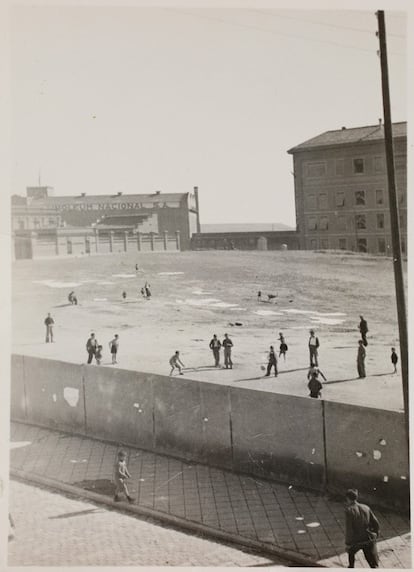A Spanish Civil War grave under a school in downtown Madrid
The Miguel de Unamuno high school, next to the old Yeserías prison, was turned into a concentration camp for Republican prisoners after the conflict. To date, no excavations have been permitted

A few meters from Atocha railway station, in the center of Madrid, there is a mass grave under the Miguel de Unamuno high school, which was used as a concentration camp at the end of the Spanish Civil War (1936-1939). Agustín López, one of the thousands of Republican prisoners held there, published his memoirs in 2015. Five years later, he returned to that site, to the same facilities that had since returned to their original function as a school, to narrate his story for television. Ever since he was 19, he had carried the pain of sleeping on the floor, on those stairs, not knowing what was going to happen to him and the rest of his classmates. After a long wait, they formed part of several battalions of soldier-laborers destined to clean up Madrid, the Alcázar of Toledo — which became a symbol of Nationalist pride during the civil war — and Sigüenza. Many others he never saw again. Despite making their story known and bringing to light other cases from the camp — such as that of Laurentino Pérez, who ended up in the Arcila camp in Africa — preserved in the Documentation Center of Historical Memory in Salamanca, so far no excavations have been allowed at the school or on the adjacent land. In that gray, undefined area between the school — a former trade center inaugurated during the Second Republic (1931-1939) — and the Yeserías prison, which had expanded its perimeter, executions took place at the end of the war, which must have coincided with those at the East cemetery and Colmenar outside the capital, until they were carried out inside the walls of prisons.
It could have been a period of three weeks, the same time that Antonio Bouthelhier, one of the chiefs of the Francisco Franco regime’s Military Police and Information Service (SIPM) in Madrid, took to write the word “normality” in the telegrams he sent to the military headquarters of the Generalissimo.
“Normality is accentuated in the life of the city, even in the periphery. Nevertheless, there are continuous queues day and night in canteens and social aid centers, still insufficiently supplied. Neighborhoods. Tetuán, Ventas and Vallecas are those which appear more refractory to the triumph of the Nationalist Movement. Evacuated large number of refugees in Madrid, crowding near the stations,” Bouthelhier wrote. On the same day he sent the telegram — April 18, 1939 — 225 people were arrested and two death sentences were carried out in the camp itself, according to the documentation of the military government of the city.
The Miguel de Unamuno high school is one of those places in Madrid’s geography that hides its wounds underground. Built in the middle of a hard-hit neighborhood, it was a miracle that its original structure remained standing. La Fundición, as the building behind it is still known today, between the school and residential buildings, was used as an ammunition factory that suffered the first impact of the so-called “logistical bombing,” of Madrid by Franco’s Nationalists, so many times later repeated by the Italian Legionary Air Force, supplied by Benito Mussolini, in Barcelona. The shock waves the aerial bombardment of the civilian population caused was one of the few sad memories that Gloria Fuertes retained from her days as a young girl. Hunger, the greatest vestige of that siege, was hidden forever under a cloak of fear and shame.
Not far away, in the municipal slaughterhouse, queues of people waited for offal or anything else they could put in their mouths to survive. Among the rubble emerged a polygon, fenced with wires and thorns, which stretched to the Abroñigal stream in the city’s southern suburbs, the limit of the firing angles set from the Garabitas hill in the former royal hunting ground of the Casa de Campo by Franco’s artillery. From this position, the Nationalist guns could guess the time when those miniatures would parade in front of their terrible kaleidoscope, but they were never ordered to demolish the prison or the station. Both remained intact, a sinister prelude to the peace that was to come. Inaugurated in 1920 as an asylum, Yeserías was converted into a prison at the end of the war. It maintained its appearance as a correctional facility and for the “redemption of souls,” as it was described on the ration cards printed there, on the banks of the river Manzanares, the new home for the families of the prisoners.

The final days of March 1939 were especially cold. The sun’s rays barely warmed a population that burned its 500 daily calories between queuing for food, engaged in the black market, or cutting branches from the few remaining trees in the Retiro Park to keep warm. The first white bread arrived with the reestablishment of electricity, water, and mail, which had been strangled by over two years of almost complete encirclement of the capital. After the curfew, and the checkpoints to pass from one district to another, came the arrests.
The Unamuno, like other centers at Campamento or Chamartín, were filled with government detainees and prisoners. The Republican Army of the Center surrendered with about 300,000 troops, who had to be classified; as Agustín recalled in his memoirs, “it was a small matter, to swear affiliation, and then they could go home, those who did not have blood on their hands.” In all the towns of Spain, big or small, devastated or untouched by war, the same scene was repeated. Despite the huge collapse, the senseless drama, everything went on as planned. The train drivers would slow down as they turned onto the Atocha line so that guards and prisoners would know that they were arriving at their destination. As soon as they got off the train, Republican prisoners were escorted by young soldiers who had not seen action at the front; walking or in trucks, which they preferred because they were better at concealing their nerves, they were distributed among some of the more than 30 buildings that served as lockups until the Carabanchel prison was inaugurated in 1944, “with all the modern advantages.” Yeserías, which a year earlier became a women’s prison, is the only one of these buildings that remains standing today. The only witness of a time, of an era, in which Madrid accounted for over 20% of the entire prison population of the country.
And, although it may seem that all this happened in prehistoric times, like the mammoths that once roamed what is today the Spanish capital, the truth is that until urban development took hold and the M-30 orbital freeway was redeveloped, that area remained an inlet in the Madrid of the civil war. It must have been around that time that its image was engraved on the Toledo Bridge, a border that would end up delimiting what remained inside and outside of national history. With no more documentary trace, the only thing left to do, like the mammoths, is to excavate the grave under the school.
Sign up for our weekly newsletter to get more English-language news coverage from EL PAÍS USA Edition
Tu suscripción se está usando en otro dispositivo
¿Quieres añadir otro usuario a tu suscripción?
Si continúas leyendo en este dispositivo, no se podrá leer en el otro.
FlechaTu suscripción se está usando en otro dispositivo y solo puedes acceder a EL PAÍS desde un dispositivo a la vez.
Si quieres compartir tu cuenta, cambia tu suscripción a la modalidad Premium, así podrás añadir otro usuario. Cada uno accederá con su propia cuenta de email, lo que os permitirá personalizar vuestra experiencia en EL PAÍS.
¿Tienes una suscripción de empresa? Accede aquí para contratar más cuentas.
En el caso de no saber quién está usando tu cuenta, te recomendamos cambiar tu contraseña aquí.
Si decides continuar compartiendo tu cuenta, este mensaje se mostrará en tu dispositivo y en el de la otra persona que está usando tu cuenta de forma indefinida, afectando a tu experiencia de lectura. Puedes consultar aquí los términos y condiciones de la suscripción digital.
More information
Archived In
Últimas noticias
Most viewed
- Reinhard Genzel, Nobel laureate in physics: ‘One-minute videos will never give you the truth’
- Pablo Escobar’s hippos: A serious environmental problem, 40 years on
- Charles Dubouloz, mountaineering star, retires at 36 with a farewell tour inspired by Walter Bonatti
- Why we lost the habit of sleeping in two segments and how that changed our sense of time
- The fall of a prolific science journal exposes the billion-dollar profits of scientific publishing









































